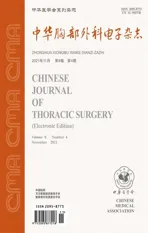Technical aspects of uniportal VATS lung major resections with bronchovascular reconstruction
2022-01-21JulioSesmaSergioBoluferCarlosGalvezFranciscoLirioJuanJosMafJoneMirenDelCampoSergioMarotoLeyreSebastianMartaOrtegaLuisJorgeCerezal
Julio Sesma, Sergio Bolufer, Carlos Galvez, Francisco Lirio, Juan José Mafé,Jone Miren Del Campo, Sergio Maroto, Leyre Sebastian, Marta Ortega,Luis Jorge Cerezal
【Abstract】 Lung major resections involving bronchovascular reconstruction pose a surgical challenge due to their technical complexity and frequency.The traditional techniques to perform vascular or bronchial reconstructions through multiportal video-assisted thoracoscopic surgery (VATS) approach can be applied also by uniportal VATS approach.Nevertheless, specific tools have already been developed in order to facilitate these procedures through uniportal VATS approach increasing comfort and workspace through the single port utility.These procedures must be performed just in very highly uniportal VATS trained teams and it is recommended that teams who perform these techniques previously have completed the advanced learning curve for lung major resections through uniportal VATS approach.The aim of this paper is to describe the major key points for performing most frequent bronchovascular reconstructions through uniportal VATS approach in a safe and feasible way.Operative technique is step by step described in order to safely perform most common uniportal VATS left/right side lung major bronchovascular resections and reconstructions.Specific tip and tricks are detailed in order to facilitate vascular control, bronchovascular reconstructions and unexpected bleeding control through uniportal VATS approach.
【Key words】 Video-assisted thoracoscopic surgery (VATS); uniportal; angioplasty; bronchoplasty;lung cancer; sleeve; bronchovascular reconstruction
Introduction
Lung major resections involving bronchovascular reconstruction pose a surgical challenge due to their technical complexity and frequency (1).These procedures are well described and mostly performed by traditional thoracotomy approach.Thoracoscopic[video-assisted thoracoscopic surgery (VATS)] approach is technically demanding but safe and feasible in selected patients and experienced teams (1-3).However,majority of teams perform multiportal approach, this procedures can be carried on by using uniportal VATS approach in teams with wide learning and experience curve (4).The aim of this paper is to review the key points for performing more frequent bronchovascular reconstructions through uniportal VATS approach in a safe and reproductible way.
Operative technique
Anesthesia, patient position and incision
The procedure is performed under general anesthesia plus double lumen tube.Less commonly, there are very selected cases that can be relayed by nonintubated surgery (5).Patient position is lateraldecubitus providing an inflatable cushion to increase the intercostal space (Figure 1).A 3—4-cm incision is made in the fifth or fourth intercostal space.Particularly in upper procedures with bronchial or vascular involvement (right and left upper sleeve lobectomies, right sleeve bilobectomy) the incision in the fourth intercostal space provides great perpendicularity and comfort in the time of the suture.
Uniportal VATS left side bronchovascular reconstruction Frequents left bronchial defects
In left side central or locally advance lung tumors surgeon faces different situations that compromise the integrity of the left main bronchus and/or the main pulmonary artery.Due to its frequency, the most present situation is left upper lobe tumor that affects main bronchus (with or without vascular involvement)requiring different vascular and bronchial reconstructive techniques related to the defect generated: simple bronchoplasty over the stem of left upper lobe bronchus(Figure 2A), wedge bronchoplasty (Figure 2B) or sleeve bronchoplasty between left main bronchus and left lower bronchus (Figure 2C).
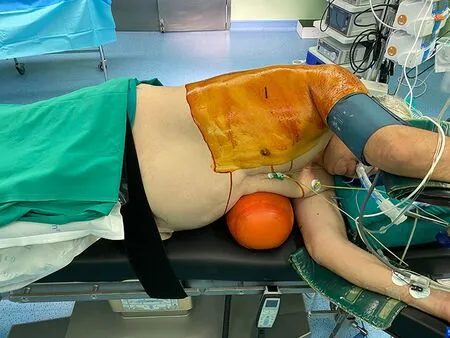
Figure 1 Uniportal VATS patient position.VATS, videoassisted thoracoscopic surgery.

Figure 2 Most common left uniportal VATS bronchial defects before reconstruction.(A) Uniportal VATS left upper lobectomy with hand bronchotomy; (B) uniportal VATS left upper lobectomy with wedge defect before reconstruction.Note membranous layer is well preserved and not disconnected; (C) uniportal VATS left upper lobectomy with sleeve defect before reconstruction.VATS, videoassisted thoracoscopic surgery.
It is important to highlight that the bronchial defect generated during resection should always be as minimum as possible but ensuring a free bronchial resection margin.Intraoperative frozen section is always recommended.However extended resections and reconstructions are sometimes needed, is always important remain that size of defect and posterior extended reconstruction imply a greater potential morbidity on the patient and should be performed only when strictly indicated.
Types of bronchial reconstruction: simple main bronchoplasty, wedge bronchoplasty and/or sleeve bronchoplasty Bronchotomy and simple main bronchoplasty
In tumors of the left upper lobe reaching left main bronchus, bronchotomy and bronchoplasty can be performed by using simple stitches in the resected area.Once the lobectomy and optimal lymphadenectomy have been completed, a fully vertical traction of the left upper lobe is recommended, clearly exposing the confluence between the left upper lobe bronchus and the main bronchus before bronchotomy (Video 1).Peribronchial dissection should be carefully done to ensure optimal lymphadenectomy and tension-free suture, trying to devascularize the peribronchial continent as little as possible, so well vascularized suture is needed to avoid postoperative stenosis.
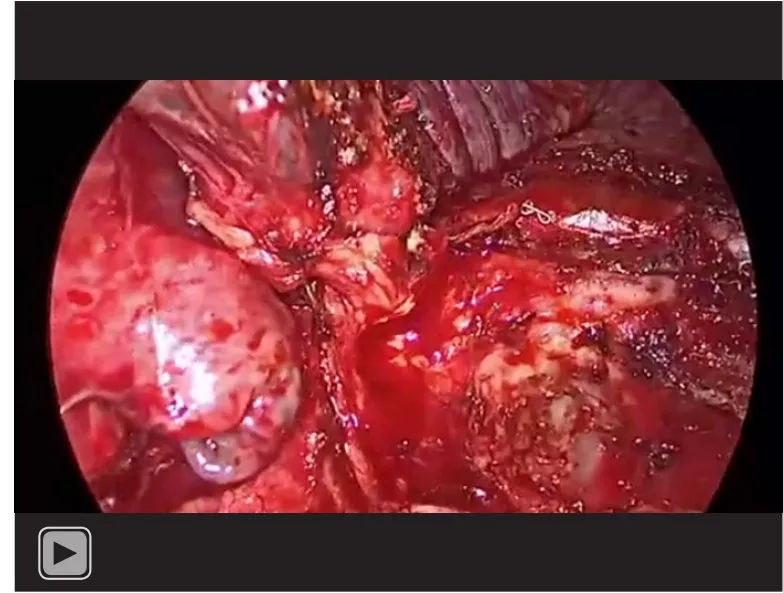
Video 1 Uniportal video-assisted thoracoscopic surgery (VATS)left upper lobectomy with simple stump bronchotomy and bronchoplasty.
Bronchotomy can be carried on with VATS scalpel and scissors, trying initially to resect as minimum as possible but with free margin (Video 1).From the upper part to the lower part of the incision (valid for both hemithorax),the instruments would be arranged such that: camera,grip or suction, scissors or scalpel (Figure 3).Ideally grasper should be hold by first assistant and that will allow the main surgeon to use the suction or any other grasp instrument as a blunt tractor that allows to expose the tissues more precisely and work bimanually.Suturing can be done using simple stitches with absorbable (3-0 Vicryl®) or non-absorbable (3-0 prolene®, 3-0 PDS®)sutures.Whenever possible, the use of small size needles (17 mm) and a specific VATS needle holder is recommended.
Wedge bronchoplasty
In selected cases with involvement of the left main bronchus, resection of the tumoral component is possible without performing a complete disconnection of left main bronchus and left lower lobe bronchus, avoiding total sleeve reconstruction.This is only possible when the extension does not affect the membranous aspect,allowing specific reconstruction by means of simple stiches of the lateral and anterior cartilaginous aspect(Figure 2B).For this, it is important to ensure adequate traction and to be meticulous when generating the bronchial defect (Video 2), an error in this step can lead to potentially avoidable sleeve.The point of greatest conflict during the generation of a wedge or sleeve defect is the pulmonary artery, which can be rejected by blunt traction of the suction or sometimes it can be pulled by suture held to the endothoracic fascia (Figure 4A,4B).Subsequently, the reconstruction is preferably performed with simple stitches (Video 2).It is very important to keep the perpendicularity at the entrance of the needle and avoid bronchial effraction with traction movements,the final result will depend on the meticulousness of the reconstruction.Likewise, as the tension area is greater on the upper face than on the lateral ends, the knotting of the points will be progressive from the lateral to the central face, in order to progressively decrease suture line tension.

Video 2 Uniportal video-assisted thoracoscopic surgery (VATS)left upper wedge bronchoplasty.

Figure 3 Arrangement of the elements in the work utility during uniportal VATS bronchoplastic procedure.VATS, videoassisted thoracoscopic surgery.
Sleeve bronchoplasty
When the extension does not allow a minor defect,a complete circumferential resection should be performed at the level of the left main bronchus andthe left lower lobe bronchus (Video 3).In this type of resection, it is important to have performed an optimal lymphadenectomy (specifically in the subcarinal area)together with the release of the pulmonary ligament,which will decrease the tension in the ascent of the suture.
To facilitate the procedure, superior traction of the pulmonary artery, is recommended by using a vessel loop,tape or silk tied to the endothoracic fascia, increasing the working space (Figure 4B).Once the defect is generated,the end-to-end running suture will be carried out.For this type of reconstruction, 3-0 prolene with a small needle (17 mm) is recommended.Running suture should start in the most-left part of the main bronchus, and it will continue right-handed through the membranous part.To facilitate this process, the distal end of the suture can be left initially sutured to the chest wall, or referenced and exteriorized through the utility incision.Once we have finished the membranous face, we change the thread to complete the cartilaginous face, finishing the knotting of both ends on the central cartilaginous face, always with the knot facing outwards to avoid granulomas.
Left side uniportal VATS vascular control and pulmonary angioplasty
Occasionally, central tumors or tumors with hilar or mediastinal lymph node involvement can compromise the main pulmonary artery, requiring vascular resection and reconstruction techniques.For both planned and unplanned vascular reconstructions, it is necessary to have the optimal maneuvers for proximal and distal clamping of the main pulmonary artery.Is possible to clamp by using traditional vascular clamps, although their use may make vascular reconstruction difficult through the utility incision, this being particularly important in the uniportal VATS approach for space and risk of clamp displacement.To this end, intracavitary tourniquets can be used through the use of a vessel loop or double silk.On the left side, to facilitate the fixation of the tourniquet, it is advisable to perform the intrapericardial dissection of the pulmonary artery and place the tourniquet proximal to de ductus (Video 4), avoiding displacement of the vessel loop.The distal tourniquet can be fixed in the pulmonary artery after dissecting the fissure, or even in large defects, to obtain working space,two separate thinner vessel loop tourniquets can be used,one for the artery of segment 6 and one for the artery of the basal segments.It is important to remark that in central tumors, control of the main pulmonary artery is recommended as the first surgical maneuver, being able to control eventual and unexpected bleeding by arranging the intracavitary tourniquet (Video 5).Once the proximal and distal clamping has been optimally performed,the arteriotomy and subsequent reconstruction can be carried out (Video 6).To this end, the reconstruction can be performed with different vascular sutures, being the prolene 4-5/0 or the GORE-TEX 4-5/0 the ones we use routinely.Much less frequently, there may be the need to perform an arterial sleeve reconstruction(Figure 5A-5C), which almost always on the left side will involve a bronchial sleeve, either due to tumor involvement, or to ensure the adequate proportion between the proximal and distal arterial ends.In extended defect, pericardial path is also an option for reconstruction.

Video 3 Uniportal video-assisted thoracoscopic surgery (VATS)left upper sleeve bronchoplasty.
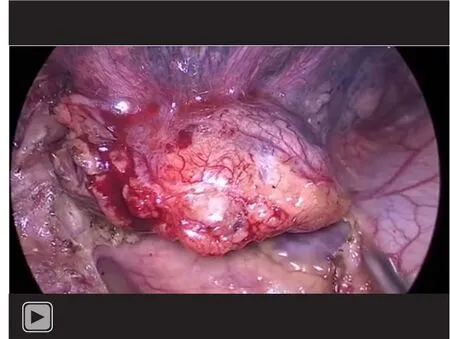
Video 4 Uniportal video-assisted thoracoscopic surgery (VATS)left intracavitary tourniquets positioning.

Figure 4 Pulmonary artery traction trick during uniportal VATS left bronchoplasties.(A) Uniportal VATS left main pulmonary artery attached to chest wall in order to increase area for reconstruction in wedge bronchoplasty; (B) uniportal VATS left main pulmonary artery attached to chest wall in order to increase area for reconstruction in sleeve bronchoplasty.VATS, video-assisted thoracoscopic surgery.

Video 5 Uniportal video-assisted thoracoscopic surgery (VATS)unexpected bleeding control with intracavitary tourniquet.
Sometimes, in very central tumors, clamping through the tourniquet is not enough, being necessary to use a vascular clamp in a more proximal position, this procedure can be performed to complete angiography in still uncomplete or punctual dehiscent angioplasty after removing the proximal tourniquet (Video 7).We must remember that, whenever possible, it is preferable to remove the distal tourniquet initially prior to the last knotting, to prevent air embolism.In addition, when facing potentially malignant lymph nodes, proximal and distal vascular control is advisable in order to safely assess the involvement of surrounding structures (Figure 6).If reconstruction is not able to provide clearly free margins,extended lung resection should be done.
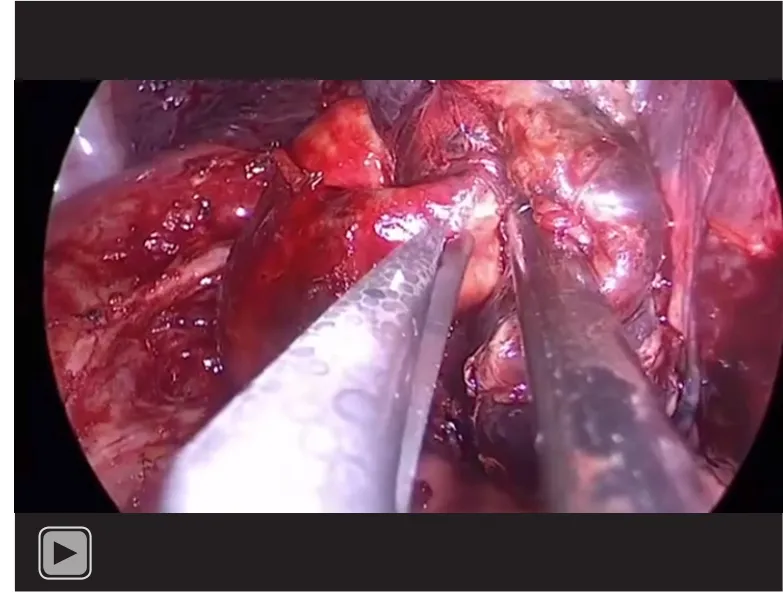
Video 6 Uniportal video-assisted thoracoscopic surgery (VATS)left upper lobectomy with angioplasty of main pulmonary artery.

Video 7 Uniportal video-assisted thoracoscopic surgery (VATS)angiography technique with proximal vascular clamp in order to control unexpected main pulmonary artery bleeding after remove tourniquet.
Uniportal VATS right side bronchovascular reconstruction Frequents right bronchial defects
On the right side, the most frequent involvement is usually the one that affects the upper lobe.Being the right upper wedge (Figure 7A) or sleeve (Figure 7B)bronchoplasty the most frequent bronchial reconstructions in right side tumors.Next in frequency are bronchoplasties that affect lower lobe, requiring wedge bronchoplasty of the middle lobe bronchus to the intermediate bronchus or even left lower sleeve lobectomy with endto-end anastomosis between middle lobe bronchus and intermediate bronchus.In selected cases, also Upper or lower bilobectomies are a procedure that could potentially need a bronchoplastic procedure (Figure 8).

Figure 5 Uniportal VATS left upper double sleeve resection-reconstruction.(A) 4-0 prolene running suture for bronchial sleeve during uniportal VATS left upper double sleeve lobectomy; (B) 5-0 prolene running suture for arterial sleeve during uniportal VATS left upper double sleeve lobectomy; (C) 5-0 prolene running suture during uniportal VATS right bilobectomy with arterial sleeve reconstruction and bronchoplasty.Note intrapericardial position of proximal tourniquet.VATS, video-assisted thoracoscopic surgery.
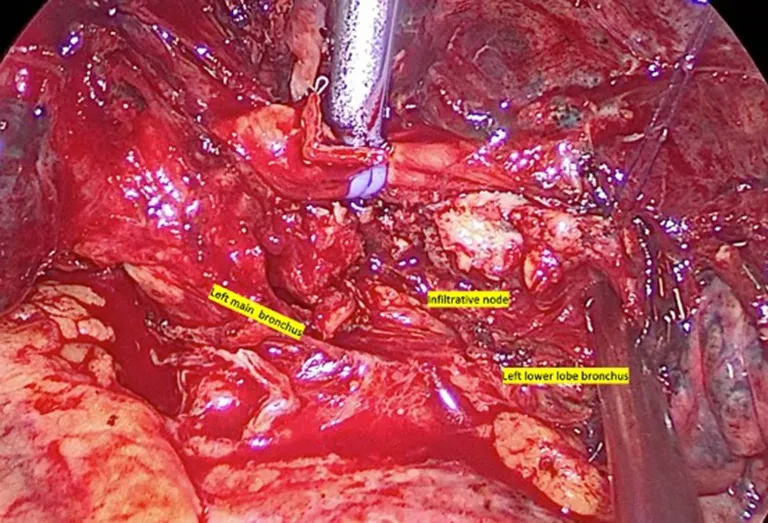
Figure 6 Uniportal VATS vascular control and left upper sleeve defect with unexpected positive lymph node infiltrating basal arterial trunk and left lower bronchus.VATS, video-assisted thoracoscopic surgery.

Figure 7 Most common right uniportal VATS bronchoplasties.(A) Uniportal VATS right upper lobectomy with wedge defect before reconstruction; (B) uniportal VATS right upper sleeve lobectomy with sleeve defect before reconstruction.VATS, video-assisted thoracoscopic surgery.

Figure 8 Uniportal VATS right upper sleeve bilobectomy.VATS, video-assisted thoracoscopic surgery.
Types of bronchial reconstruction: simple main bronchoplasty, wedge bronchoplasty and/or sleeve bronchoplasty Bronchotomy and simple main bronchoplasty
It is possible that tumoral affectation is just located at the entrance of the right upper lobe bronchus but without allowing the use of an endostapler, in this case the bronchotomy with punctual suture of the right upper lobe stump is an option.Usually, due to the size of the tumors that condition this defect and to ensure margins, it is at least necessary to perform a wedge-type reconstruction.
Wedge bronchoplasty
(I) Right upper lobe wedge bronchoplasty
In the right upper lobe this type of reconstruction represents a significant challenge for the surgeon.As there is no total disconnection of the bronchial tree, it is necessary to perform a perfectly averaged and tensionfree suture (Video 8), since any defect of this type can lead to kinking or bronchopleural fistula of the suture line.Indistinctly, the reconstruction can be performed with absorbable or non-absorbable suture, being the preferable to use a 3-0 thread and a small needle (17 mm)to be more precise and avoid surrounding structures.
(II) Right lower wedge bronchoplasty
In large tumors affecting the right lower lobe, this type of reconstruction may be necessary.Section is performed close to the lower lobe bronchus, since the section in the carina with the middle lobe bronchus could condition a potentially avoidable sleeve.Once the defect has been made, the suture will be performed using simple stitches,paying special attention not to stenosis the middle lobe bronchus (Video 9), if this happens and the ventilation of the parenchyma is not optimal, it is indicative of the need for a sleeve-type reconstruction.
Sleeve bronchoplasty
On the right side, the sleeve procedures that concern the upper lobe are the most frequent sleeves.In the right upper sleeve lobectomy, vascular relationships with the suture area are important, since the pulmonary artery will be located anterior to the reconstruction and the azygous vein will be found in the cranial part of the anastomosis.Sometimes it is necessary to perform vascular control of the pulmonary artery by using a tourniquet to perform the suture under safe conditions.In order to obtain greater proximal bronchial margin, the azygous vein can sometimes be sectioned.In sleeve-type right upper lobectomy, it is important to perform the minimum possible resection to achieve good margin, so this will ensure less tension on the anastomosis.Reconstruction is performed by using a running suture, preferably with a 3-0 non-absorbable suture (3-0 prolene®).To orient ourselves in right side sleeves, a little trick is to observethat the pars membranosa faces the posterior parietal pleura.This fact is of special importance, since it is advisable to start the suture in the most posterior region of the cartilaginous component, releasing tension in this area first.The suture begins with an inside-outsideoutside-inside stitch, with the distal end anchored to the endothoracic fascia (Video 10) in the same way as in left procedures.For this type of suture, we recommend having specific VATS instruments that allows exposing the bronchial continent and stitches in the same direction whenever possible (generally right-handed)(Video 11).
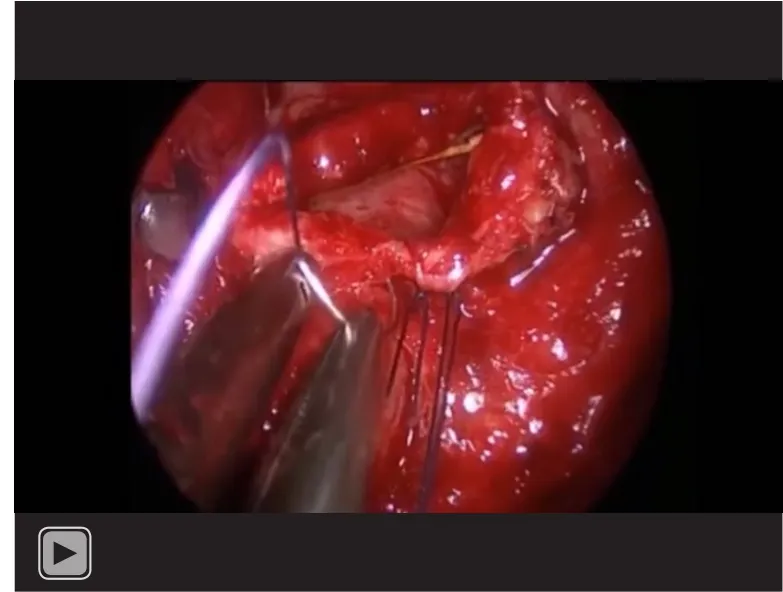
Video 8 Uniportal video-assisted thoracoscopic surgery (VATS)right upper wedge bronchoplasty.
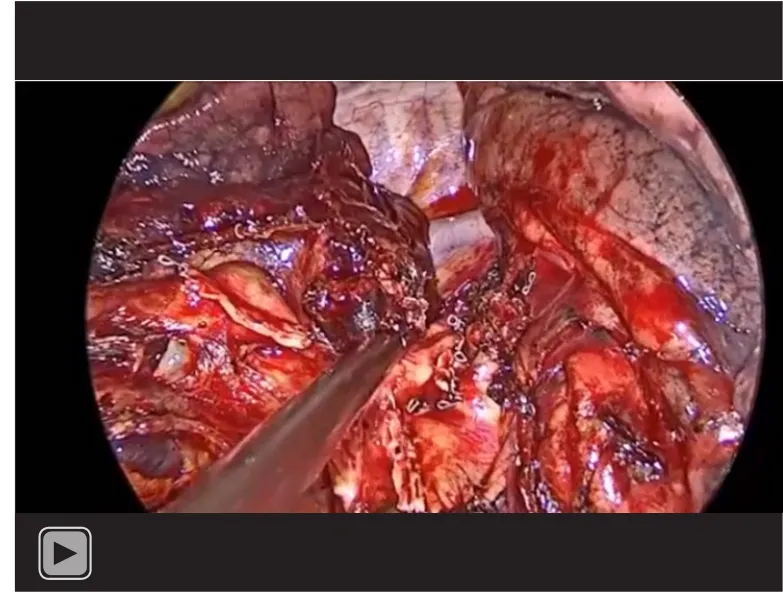
Video 9 Uniportal video-assisted thoracoscopic surgery (VATS)right lower wedge bronchoplasty.
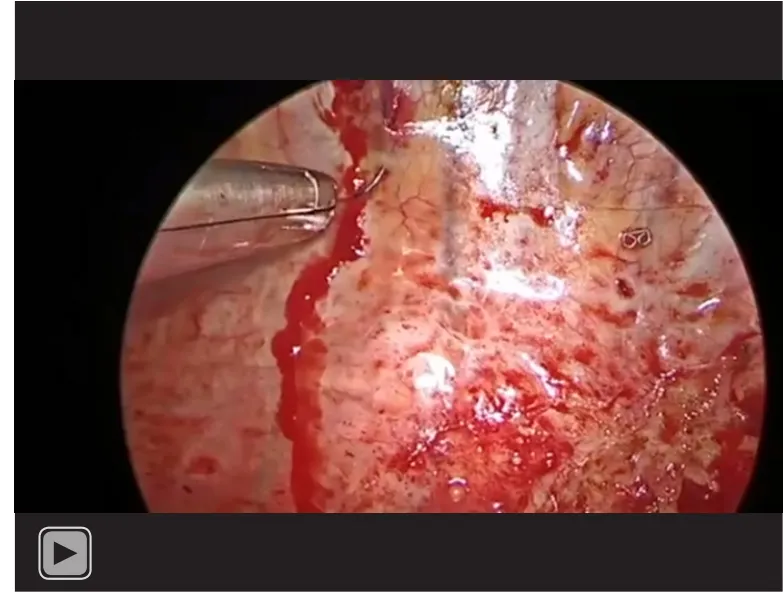
Video 10 Trick for sleeve procedures: the distal end of running suture is fixed to the endothoracic fascia.
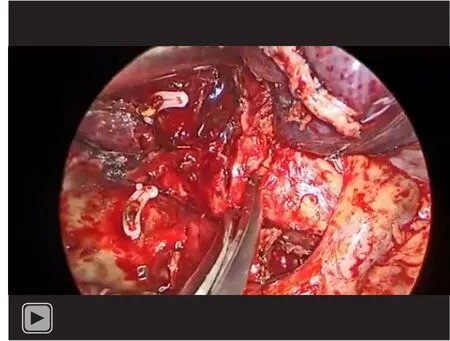
Video 11 Uniportal video-assisted thoracoscopic surgery(VATS) right upper sleeve lobectomy.
Right side uniportal VATS vascular control and pulmonary angioplasty
Angioplasties on the right side are specially difficult due to size of main pulmonary artery and the absence of ductus to fix the tourniquet, so special care with displacement should be taken.In selected defects it is possible to place tourniquets or if surgeons prefer use intracavitary vascular clamps and perform reconstruction(Video 12).Nevertheless, to avoid a potential displacement of vascular tourniquet, it is advisable to perform intrapericardial control of pulmonary artery(Video 13).In this way the intracavitary tourniquet will be fixed by the pericardial laminae on its upper and lower slopes.Distal control of main pulmonary artery can be performed in the fissure or even proximal if bilobectomy is not needed.

Video 12 Uniportal video-assisted thoracoscopic surgery(VATS) right angioplasty with proximal tourniquet and distal intracavitary vascular clamp.
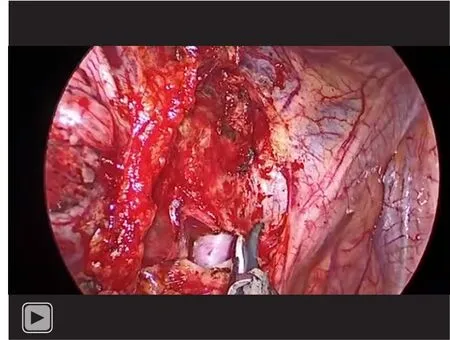
Video 13 Uniportal video-assisted thoracoscopic surgery(VATS) right intrapericardial vascular control of main pulmonary artery.
Suture coverage
Suture line coverage is a recommended option in reconstructions over extensive resections or in cases where also vascular component is involved.Pericardial fat, periaortic pleura or even diaphragmatic muscle for extended resections (i.e., sleeve pneumonectomy) can be interposed.
Discusion
Bronchovascular reconstruction procedures have been previously well described using the open thoracotomy approach (6).Carrying out these procedures using a minimally invasive approach has required the adaptation of the instruments and technique in a specific way to facilitate the procedure (1-5).Although the uniportal VATS approach allows to safely reproduce the bronchial and vascular reconstruction techniques performed in multiportal VATS or open surgery, these procedures must be performed just in very highly VATS trained teams.
Conclusions
Lung resections involving vascular or bronchial resection and reconstruction are safe and reproducible by using the uniportal VATS approach in highly trained teams.
Acknowledgments
To my wife and daughter, for their unconditional love and support.
Funding:None.
Footnote
Provenance and Peer Review:This article was commissioned by the editorial office,Chinese Journal of Thoracic Surgeryfor the “International Thoracic Surgery Column”.The article has undergone external peer review.
Conflicts of Interest: All authors have completed theICMJE uniform disclosure form (available at https://dx.doi.org/10.3877/cma.j.issn.2095-8773.2021.04.02).The “International Thoracic Surgery Column” was commissioned by the editorial office without any funding or sponsorship.JS serves as an unpaid editorial board member ofChinese Journal of Thoracic Surgeryfrom April 2021 to March 2023.The authors have no other conflicts of interest to declare.
Ethical Statement:The authors are accountable for all aspects of the work in ensuring that questions related to the accuracy or integrity of any part of the work are appropriately investigated and resolved.
Open Access Statement: This is an Open Access article distributed in accordance with the Creative Commons Attribution-NonCommercial-NoDerivs 4.0 International License (CC BY-NC-ND 4.0), which permits the noncommercial replication and distribution of the article with the strict proviso that no changes or edits are made and the original work is properly cited (including links to both the formal publication through the relevant DOI and the license).See: https://creativecommons.org/licenses/by-ncnd/4.0/.
